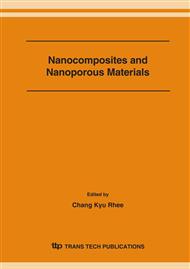p.203
p.207
p.211
p.215
p.219
p.223
p.227
p.231
p.235
Preparation and Characterization of Environmental-Friendly Epoxy Resins/Clay Nanocomposites
Abstract:
The environmental-compatible epoxy resins/clay nanocomposites were prepared by using epoxidized castor oil (ECO) and two ion-exchanged clays. The glass transition temperature (Tg) and mechanical interfacial properties of ECO/clay nanocomposites were investigated. As a result, the nanocomposites showed higher Tg than that of neat ECO. The mechanical interfacial properties of both the nanocomposites were significantly increased on increasing the clay content.
Info:
Periodical:
Pages:
219-222
Citation:
Online since:
January 2007
Authors:
Keywords:
Price:
Сopyright:
© 2007 Trans Tech Publications Ltd. All Rights Reserved
Share:
Citation:


